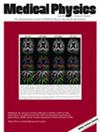Uncertainty quantification for CT dosimetry based on 10 281 subjects using automatic image segmentation and fast Monte Carlo calculations
Abstract
Background
Computed tomography (CT) scans are a major source of medical radiation exposure worldwide. In countries like China, the frequency of CT scans has grown rapidly, thus making available a large volume of organ dose information. With modern computational methods, we are now able to overcome challenges in automatic organ segmentation and rapid Monte Carlo (MC) dose calculations. We hypothesize that it is possible to process an extremely large number of patient-specific organ dose datasets in order to quantify and understand the range of CT dose uncertainties associated with inter-individual variability.
Purpose
In this paper, we present a novel method that combines automatic image segmentation with GPU-accelerated MC simulations to reconstruct patient-specific organ doses for a large cohort of 10 281 individuals (6419 males and 3862 females) who underwent CT examinations at a Chinese hospital. Through data mining and comparison, we analyze organ dose distribution patterns to investigate possible uncertainty in CT dosimetry methods that rely on simplified phantoms population-averaged patient models.
Methods
Our data-processing workflow involved three key steps. First, we collected and anonymized CT images and subjects’ health metrics (age, sex, height, and weight) from the hospital's database. Second, we utilized a deep learning-based segmentation tool, DeepContour, to automatically delineate organs from the CT images, and then performed GPU-accelerated MC organ dose calculations using a validated GE scanner model and the ARCEHR-CT software. Finally, we conducted a comprehensive statistical analysis of doses for eight organs: lungs, heart, breasts, esophagus, stomach, liver, pancreas, and spleen.
Results
It took 16 days to process data for the entire cohorts—at a speed of 600 individual CT dose datasets per day—using a single NVIDIA RTX 3080 GPU card. The results show profound inter-individual variability in organ doses, even when only comparing subjects having similar body mass index (BMI) or water equivalent diameter (WED). Statistical analyses indicate that the data fitting—a method often used in analyzing the trend in CT dosimetry—can lead to relative errors exceeding as much as 50% for the data studied for this cohort. Statistical analyses also reveal quantitative correlations between organ doses and health metrics, including weight, BMI, WED, and size-specific dose estimate (SSDE), suggesting that these factors may still serve as surrogates for indirect dose estimation as long as the uncertainty is fully understood and tolerable. Interestingly, the CT scanner's tube current modulation reduces the average organ doses for the cohort as expected, but the individual organ dose variability remains similar to those from scans having a fixed tube current.
Conclusions
Using newly available computational tools, this study has demonstrated the feasibility of conducting big data analysis towards CT dose data mining and uncertainty quantification. Results show that inter-individual variability is significant and can be taken into account in an effort to improve CT dosimetry.

 求助内容:
求助内容: 应助结果提醒方式:
应助结果提醒方式:


